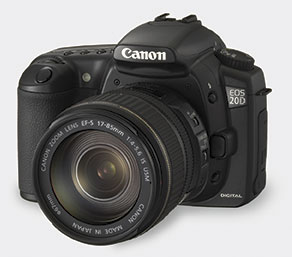
This review and tests were performed on a pre-production camera. Its performance may not therefore
be reflective of what full production cameras will be like. Once a full production camera is available
it will be re-tested and this review will be updated if there are noticeable differences.
August 20, 2004 (5pm EDT, Aug 19)
Canon has announced the EOS 20D. This is their fourth-generation prosumer DSLR, following the D30, D60 and 10D. Shipment will begin in September, and the retail price will likely be lower than that of the previous 10D, though it will of course vary from country to country.
The key questions that everyone wants to know are — what are the new features, how well do they work, and how does the camera handle in the field? After nearly a week of using a pre-production camera here are my initial impression. Part Two of this report contains sample images as well as some test results and analysis. If you want a complete run-down on all of the camera’s knobs and buttons you will find these on the Canon web site as well as on specialist camera reviews sites. This review assumes that you’re familiar with the basic features of either this sort of camera in general or Canon’s mid-range DSLRs in specific.
Here are the salient new features. I’ll be discussing them in greater detail further on in this review.
— an 8.25 Megapixel CMOS sensor (1.6X cropping factor)
— 5 Frames per second shooting speed
— shooting buffer of up to 23 large JPGs or 6 raw files
— 1/250 sec flash sync
— E-TTL II flash technology
— smaller size and lighter weight than the predecessor 10D
— DIGIC II processer chip for faster operation
— essentially instantaneous camera turn on
A New Body
At first glace the 20D looks almost identical to the 10D. But in fact it has an entirely new chassis. For one thing, it is smaller and lighter. Approximately 3.5 oz lighter and some 13% smaller. Smaller in fact in every dimension. You really have to hold them side-by-side to see the differences, but when you do it’s quite noticeable. It’s not quite as small and light as the Digital Rebel, but the chassis of the 20D is magnesium alloy rather than polycarbonate.
Some of the subtle but obvious differences are slightly sharper edges to some of the body lines and a less contoured grip. The prism and flash assembly is flatter, but projects further forward. This means that the pop-up flash stands higher when elevated, and this gives much better flash coverage. It clears most lens hoods (but not that on the 17-40mm) and it almost completely eliminates red-eye.
Not that it matters much, but the Canon logo on the top front of the camera is now embossed and painted rather than just stenciled, making the camera look just a bit more refined. The mode dial has been changed as well, but to my eyenotfor the better. The one on the 10D looked slicker in finish.
The rear panel shows several changes. The On / Off knob for exposure compensation located above the command wheel has been replaced with a multi-controller joystick, and the 10D’s navigation button located below the Jump button has been removed. The left hand rear buttons are now slightly recessed, making them less likely to be accidentally depressed, especially when wearing gloves. The camera’s main On / Off switch now has a third position that activates exposure compensation via the Command Dial. Finally, the card activity light which was visible though a tiny window in the card access door has now been moved to the rear panel, something that I commend Canon for, because it was always awkward to view before.
The memory backup battery is no longer on the base of the camera, rather it has been moved to inside the main battery compartment door. The main battery is now higher capacity then before, a 1380 mAh BP511A Lithium Ion rechargeable, rather than the previous BP-511, though if you have some of the older batteries they will fit and can still be used. The USB port is now USB 2.0, for faster file transfers.
Otherwise all of the standard features of the 10D are continued, including an illuminated top LCD panel, and a logically arranged menu structure found on a single scrolling screen.
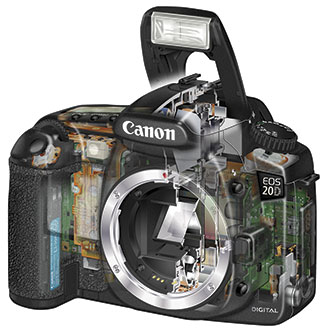
BG-E2 Grip
There is a new battery grip available, the BG-E2. It will not fit the 10D, nor will the previous BD-EG3 fit the 20D. The grip takes two rechargeable batteries, extending shooting time before batteries need to be replaced, providing a heftier grip when shooting with large lenses, and also providing a vertical shutter release.
Two noticeable improvements to the grip are that the exposure lock and metering selector buttons duplicate the playback magnification functions of the ones found on the camera, and there is now also an adaptor which allows regular AA batteries to be used in a pinch. This will be a real plus for anyone that finds themselves shooting away from AC power, such as on a camping trip.
By the way. Did you know that the slot inside the BG-E2 and BD-EG3 which is intended to hold the camera body’s battery cover when the grip is attached can be used instead to hold an extra CF card? Thought you’d like to know.
The 8.25 Megapixel Imaging Chip
This of course is the big news about the 20D. The pixel dimensions are 3504 X 2336. There are now just two DLSRs available with 8MP sensors, the Canon 1D MK II and the 20D. The only larger chips found in 35mm DSLRs are the 11MP chip in the Canon 1Ds and the 14MP chip in the Kodak SLR/n/c. Of course that’s today. Anything that may be announced at Photokina in late September could well change the game again.
But, it’s safe to assume that most of Canon’s competitors in the price range of the 20D will being going into the third quarter of 2004 with 6MP cameras. (I hope that I’m wrong. There’s nothing like competition to keep everything moving along.) If this is the case though it will give Canon a big competitive leg-up for a while. And, as will be seen in the remainder of this first-look review, the 20D is such a competent camera in other areas as well that it’s likely to be the industry’s feature / function leader, at least though the rest of 2004.
The chip’s physical size remains the same as that of the 10D and Canon’s previous APS-C sized imagers (22.5 X 15mm), with a 1.6X magnification factor. Of course to fit 8 Megapixels into the same space previously occupied by 6 Megapixels means that the individual pixels (photo-sites) have had to be made smaller. Indeed their size is now 6.4 microns vs. 7.4 microns for those on the 10D’s imaging chip. (By way of comparison, the Canon 1Ds has 8.8 micron pixels, while the Olympus E1’s Kodak designed and built CCD uses 6.8 micron photo sites. Leica’s forthcoming 10MP back for the R9 will have similar pixel pitch. Digicams typically have 3 micron or smaller sensors).
Now, common wisdom is that the smaller that photo-sites are made the noisier they get. This is essentially correct, and we have seen this with the recent generation of 8 Megapixel digicams, where very small pixels lead to quite high noise levels, especially at ISOs above the chip’s native level. But progress is constantly being made, and my bench tests show that the 20D has essentially identical noise to that of the 10D at all common ISO settings. Canon has accomplished this by placing improved noise reduction circuitry right at the chip level. The camera also has long exposure noise reduction as an option, which the 10D didn’t, but the previous D60 did. Or was it the other way round? Well, in any event, the 20D has it.
Speeds up to and including ISO 400 are virtually noise free. As will be seen in Part II of this review, ISO 1600 is remarkably good. Even ISO 3200 (setable via a custom function) is usable for many applications. Those that were convinced that an 8MP chipped camera must have a lower signal to noise ratio than one with a 6MP chip will be chagrined, and those that hoped that it wouldn’t be the case can now breath easy.
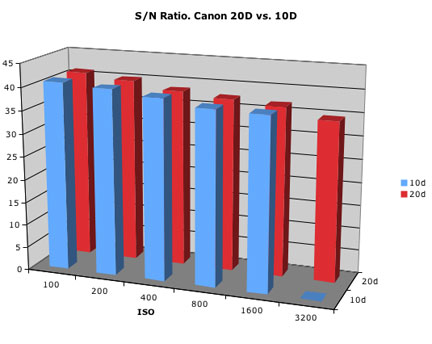
| ISO | 10D | 20D |
| 100 | 40.9 | 41 |
| 200 | 40.2 | 40 |
| 400 | 39.2 | 38.4 |
| 800 | 37.7 | 37.5 |
| 1600 | 37.4 | 36.8 |
| 3200 | NA | 34.6 |
Interpretation:
The signal to noise ratio of the 20D compared to the 10D is essentially identical.
Please note (as mentioned in this site’sDxO Tutorial), that — "DxO Analyzer is in pre-release, and S/N measurements are based on the average luminance level of the test image.
This means that it is not possible to accurately compare cameras whose test shots were made at different luminance levels". For this reason, please do not compare these S/N numbers to any others on this site. The tests above though were all done at the same time at the same illumination level and therefore are self-consistant.
I believe that they therefore reflect the actual S/N difference between these cameras, and certainly between the specific camera bodies that were tested.
An 8 MP chip produces a 23MB 8 bit file when opened in Photoshop. At a printing resolution of 240 PPI this produces approximately a 10X15" image, nicely filling an A3 piece of paper — as big as most people ever print. For many photographer though this extra data will also be valuable when cropping is needed. Five and six megapixel cameras have always found themselves somewhat limited in this regard when compared with either scanned film or full-frame sensors.
High Frame Rates
Possibly one of the most exciting and valuable of the camera’s new features is its high speed shooting capability. At 5 FPS the 20D is only bested in shooting speed among current DSLRs by the Canon 1D Mk II and the Nikon D2h. Particularly at its price point there isn’t another camera that comes close. And, when you see that in large JPG mode it can shoot 23 frames continuously at this speed (6 in raw or JPG+raw), you realize how significant this will be for many photographers.
Just a word of caution though. Because of the large 8MP chip on the 20D, with only 80 frames (raw+large JPG) on a 1Gigabyte card, you can imagine how easily and quickly a card can be filled when shooting sports or wildlife, for example. Anyone planning on shooting a lot of high-speed bursts should plan on having a pocketful of 1GB or larger cards on hand.
The Viewfinder
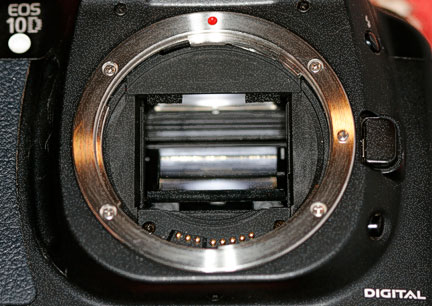
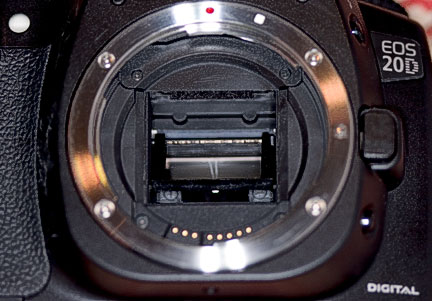
As mentioned, the 20D has been reduced in size over the 10D and previous models in this line from Canon. Such shrinkage is not without its price though. It has been achieved by reducing the size of both the pentaprism and the instant return mirror. This makes the viewfinder a bit dimmer and a bit coarser than the previous generation. The coarseness isn’t all that apparent indoors or under low contrast outdoor light conditions, but outdoors on a bright sunny day it’s painfully obvious. (Canon claims that the coarseness to aid manual focusing, but that’s just marketing BS; simply an attempt to turn a deficiency into a feature).
Everything is a trade-off. Consumers want faster and better digital cameras and expect to pay less for it than they did at this time last year. Manufacturer’s are squeezed to make a profit and be competitive in a ruthless and fast changing environment, where you’re only as good as your latest product. Canon has obviously decided that smaller, lighter and less expensive to build is the success formula for the 20D, so long as the buyer still gets a bigger sensor, clean images and faster shooting speeds.
Is the trade-off worthwhile in this case? I believe so. Unless one looks though the viewfinder of a 1Ds, and then one realizes thehugegap that exists in viewfinder brightness and size between models and between these price ranges. The reason that I believe that consumers will accept the situation is because in the end they are getting perceived value, and the somewhat darker and grainier viewfinder of the 20D is a price they’ll likely be willing to pay.
Built-In Flash
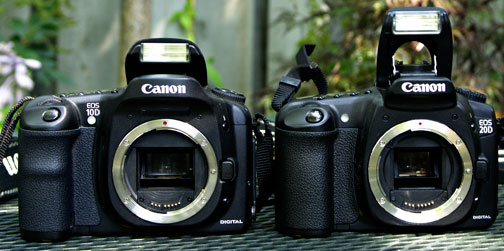
The flash built in to the 20D is one of the best such units that I’ve ever used. It has a guide number of 13/43 (ISO 100, in meters/feet), making it moderate in power. But it excels in providing high quality images, both in low light and in mixed ambient conditions. The camera has Canon’s new E-TTL II system, first introduced on the ID Mk II body, and this therefore applies to the built-in flash as well. You can read more about ETTL-IIhere.
Most noticeable about the new flash design is that it extends much higher above the lens than did the one on the 10D. This means that it will clear the lens shades on many lenses, and more importantly, the extra height really helps to reduce red-eye. There is also a red-eye reduction function that can be turned on and off through the menu system. Flash sync speed for the camera is 1/250 sec with Canon EX flash units and the built-in flash will cover the field of a 17mm lens. Recycle time is 3 seconds.
Nine Focus Points
Autofocus on the 20D is based on a new 9 points focus array. The center point is a cross type sensor when used with lenses that are f/2.8 or faster, and it and the remainder are sensitive on either the horizontal or vertical axis with lenses having maximum apertures down to f/5.6. The sensor count is up from 7 points on the 10D, and is similar to the equivalent layout of that on a Canon 1 Series camera when set to 9 point configuration. There is the usual One Shot as well as AI Servo tracking with predictive autofocus. Canon claims that the new autofocus is superior to that on the 10D with stationary subjects, but I wasn’t able to confirm this during my tests. In addition there is AI Focus mode which locks focus in Single Shot mode but then automatically switches to AI Servo with tracking if the subject starts moving while the shutter release is partially depressed. The focus points used illuminate in the viewfinder in One Shot mode only.
The Multi-controller & Focus Point Selection

The biggest interface change on the 20D is the addition of the Multi-controller. This sounds fancier than it really is, but it does make quite a difference in how certain functions are performed. It is mainly used to change focusing points, a much quicker and intuitive method than the use of the control dials. It can be activated with the usual AF point selection button, or though the use of a Custom Function it can be made live at all times without having to press the button. When the center of the joystick is pressed it selects the center point, and then pressing the AF point activation button reselects automatic point selection mode. Really convenient.
The Multi-controler is also used in playback mode to navigate around the image.
Turn Me On
The Canon 20D is the first Canon digital camera that has essentially no turn-on delay. None. Zip. Nada. Well, maybe it isn’t instantaneous, but it’s as close to it as I can measure. (Apparently it is rated at 200 milliseconds). The 10D, by comparison, has a turn-on delay of about 3 seconds.
I regard this as a major advance in the state of the art. One of the long-standing criticisms of digital cameras by many photographers has been their inability to be instantly available to take a shot when needed, unlike film cameras. With the 20D those days are now over.
Here’s a way to test it. With the camera turned off, hold down the shutter release and then turn the camera on. What you’ll find is that the shutter fires the moment that the switch reaches the On position.
The same thing applies to turn-on when the camera comes out of sleep mode. Just touch the shutter release and it’s on and ready to shoot. For this reason I found myself setting the camera to a two minute turn off, and just left it there, not bothering with the power switch at all except when I put the camera in a bag. That way I didn’t have to check to see if the camera was powered-up or not. I simply would start shooting. One more advantage of shooting film bites the dust.
White Balance Correction

The 20D has a full compliment of colour balance options, including Auto White Balance, the usual half dozen separate settings such as Daylight, Tungsten, etc; the ability to set degrees Kelvin directly if you’re using an external colour temperature meter, and custom white balance, whereby you shoot a white or gray card and then set while balance accordingly.
But a new white balance capability has been added, and it’s both fascinating and puzzling at the same time. There is a menu item in the LCD screen titled WB SHIFT / BKT. This allows one to use the joystick Multi-controller to move a cursor around a screen with a dual axis matrix, with the Blue / Amber axis going left to right, and the Green / Magenta axis vertically. Each square represents a 5 mireds shift along the respective axis.
The rear control wheel can then be used to set a white balance bracketing range related to the shift that has been entered with the Multi-controler. And this then can be combined with auto exposure bracketing to shoot up to 9 different frames. Sounds complicated? Well, it sort of is, though it’s easy to execute once you understand what’s happening.
Here’s the puzzlement though. Who is it for? It’s completely redundant if you’re shooting in raw mode, and indeed can’t even be set unless you’re shooting JPG, since all colour balancing can be done much more conveniently in raw mode during post processing. That means that its intended only for someone shooting in JPG mode, but this begs the question of who would that be, and for what purpose?
If a photographer cares about a 5-15 mired of colour temperature conversion difference (this is a very small and subtle amount) then they’ll want the ultimate control of raw mode. JPG shooting is for high volume, and shooting where factors other than ultimate quality are paramount. Frankly, the whole thing is a mystery, and seems to have been designed more for specmanship in the marketing wars than for practical application in the real world. Camera salesman will love it. Photographers will likely ignore it. But it does look cool.
There are also a large number of B&W filter effects which can be used to create monochrome images, emulating the effect of using coloured filters with B&W film. I didn’t have an opportunity to experiment with this, and I personally prefer to do my B&W conversions after the fact in Photoshop, but I know that a great many people will find the ability to shoot in B&W mode useful and fascinating.
20D vs. 1D Mk II
A debate that will ring through the web’s discussions forums for months to come is one which compares the 20D to the 1D Mk II. They’re both 8 Megapixel cameras, and though not quite as fast as the Mk II, at 5FPS the 20D is fast enough for many photographers. The price difference is considerable, and so why not buy a 20D instead of the much more expensive Mk II?
Indeed. But the answer is obvious, and so to debate the point (and I know it will be done, ad nauseam) serves little purpose. Here are the main pros and cons:
— the Mk II is much more expensive (nearly three times the price)
— the MK II is much bulkier and heavier
— the Mk II is a lot faster, more so than just the number of frames per second would suggest
— the Mk II has a 1.3X factor vs. the 20D’s 1.6X cropping factor
— the Mk II has larger photosites (pixels) and therefore a theoretical (at least) advantage in terms of noise at high ISO
— the Mk II has far superior weather sealing
— the Mk II is considerably more ruggedly built
— the Mk II has a 200,000 cycle shutter
— the Mk II has a significantly larger and brighter viewfinder
— the Mk II has a much larger buffer
— the Mk II has spotmetering and 45 point autofocus
There you have it, the major pros and cons. Now simply ask yourself; given these differences, is the extra cost, weight and bulk of the Mk II appropriate for the type of shooting that you do? If so, go for it. If not, then the 20D may well be the camera that you’ve been looking for.
What’s Missing?
I have a couple of pet peeves with Canon’s whole line of DSLRs. One of them is that it takes multiple button presses and screen references to set mirror lock-up. Now, maybe Canon’s market research tells them that it’s enough to simply provide the feature (which some major manufacturers don’t anymore). But every Canon photographer that I talk with has the same complaint, so it ain’t just me. Come-on Canon! If you don’t want to go to the trouble and cost of adding an extra button (the way it should be), then make it part of a 2 second self timer. It’s just a few lines of code.
The second issue has been there on the D30, D60, 10D and now the 20D, and that’s the lack of a quickly visible ISO setting. I’ve bitched about this before, so it’s nothing new, but I have to ask;doesn’t anyone in Canon’s engineering department ever take photographs? Because, if they did, they would have immediately noticed that you have to press a button to see the current ISO setting, and in no instance is it visible in the viewfinder.
With digital cameras the ISO sensitivity setting is the third handy exposure variable after aperture and shutter speed. Unlike with film, where you load a film of a certain speed and then you’re stuck with it for a while, most digital photographers are constantly changing the ISO as the light changes, especially with today’s slow zoom lenses where it’s often necessary to bump up to a higher setting to keep the shutter speed in a usable range. Not having the ISO in the viewfinder right next to the shutter speed and F/ stop simply shows me that Canon’s designers aren’t really photographers, or this would have changed long ago. At a minimum it should be always visible on the top panel LCD.
Fix these two glaring omissions by the next model. Or else! (Or else what? Or else I’ll keep complaining about it until you do). Maybe I should start a write-in campaign.
Canon EFS 17-85mm f/4.5-5.6 IS
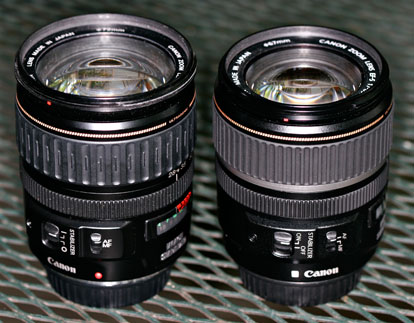
This lens surprised me for several reasons. Firstly, it’s an EFS lens, which means that it is designed for 1.6X reduced-frame sensors like those in the 20D and the D300 / Digital Rebel. It will not work with either a film-based Canon camera or a full frame (or almost so) digital body such as the 1D Mk II or 1Ds. It will not even mount on a 10D or predecessor camera even though the coverage would work. A special lens mount fitting is required on the camera body.
This focal length and configuration is equivalent to Canon’s 28-135mm IS lens on a film or full-frame digital body. The older 28-135mm is of course equivalent to a 45-216mm lens on a 1.6X camera like the 20D, so a direct comparison isn’t really possible. (Of course the initials IS in the name mean that it is an Image Stabilized lens, offering about 2 stops of additional hand-holdability).
I’ve been critical of reduced frame lenses until now primarily because of a concern that an investment in such a lens meant that it’s use is limited to a 1.6X chipped camera, and wouldn’t be usable down the road with a full-frame digital body. But I’m now revising my opinion. It appears that Canon as well as most other manufacturers are bringing out an increasing number of such lenses, and it’s therefore likely that this chip format will be with us for some time to come. This being the case then buying a small selection of these lenses will make sense for some photographers.
This lens is a case in point. It’s small, light weight and covers a focal length range that is ideal for travel and casual daily use. Add its IS capability and you have a combination with the new smaller and lighter 20D body that almost challenges the better 8MP digicams in weight if not size. It’s a compelling combination, and one that I wouldn’t hesitate to take along as a one body / one lens vacation system. Given the low noise characteristics of the 20D the f/4-f/5.6 maximum aperture on this lens is less of an issue than it would have been with earlier digital cameras or with film cameras. Bump the ISO to 400 or even 800 and in combination with the one to two stops of extra shutter speed achievable with IS it’s like working with an f/2 lens would have been just a few years ago.
I never thought I’d find myself writing this, but this reduced-frame S series len is appealing. I would just caution anyone shooting with both reduced frame cameras like the 20D and also with either film or full-frame digital bodies that you should only consider an investment in such S series lenses with an idea of your future needs clearly in mind.
The Bottom Line
The Canon 20D is an excellent picture taking machine. Given its 8 Megapixel sensor, 5 frames / second shooting capability, instant turn-on, large buffer, extremely low noise, and excellent battery life, it’s hard not to give this camera an A. I might have even been tempted to give it an A+ if it weren’t for the missing ISO setting in the viewfinder and stupid mirror lock up sequence. The smaller dimmer viewfinder also knocks it down a peg.
As frequent readers know, I’m a hard marker. For me, how well a camera handles in the field is as important as its image quality. A camera can produce stunning image quality, but if it can’t be used efficiently on location it goes to the back of the class. Some photographers scoff when I critique things like control placement and handling when wearing gloves, and if they only use their cameras to take picture of their kids during summer holidays then my critiques aren’t that relevant for them. But for photographers who shoot hundreds if not thousands of frames a month throughout the year these are the things that make a difference between a useful tool and a frustrating boat anchor.
If you accept the Canon design idiom (and not everyone does so comfortably), then the 20D is a fourth generation refinement that scores extremely well. No, it’s not perfect, but then, what is? But given its price / feature and performance equation I believe that when it starts shipping in September the 20D will offer the best value in its class.
Of course potential buyers will want to ask two questions. The first will be — should I get the 20D over one of the other DSLRs from another manufacturer? No sensible answer can be given to this question because there are too many variables. You really need to visit a dealer and try each camera to see how they handle and feel. And it t also will depend on whether or not you already have lenses in one manufacturer’s mount or another.
The second question will be from Canon 10D owners wondering if they should upgrade. This is tough to answer as well because even assuming that money isn’t an issue, though it is for most people, the improvements of the 20D over the 10D are real, but incremental; noticeable and useful, but except for turn-on speed, not earth-shattering. My suggestion would be to go for it, but to keep the 10D as your back-up camera if you can. Or give it to your brother-in-law as a gift.
As for me, I’ve already ordered my 20D and 17-85mm, as both an excellent light-weight travel system, and as backup for my 1Ds. It’s that good.
An EF-S 10 – 22 mm F3.5 – F4.5 (16 – 35 mm equivalent) is also coming, but I have no additional details at this time and a sample was not available for testing.
You May Also Enjoy...
Zion National Park
Zion Cliff. Utah. March, 2009Phase One 645AF with P65+ back and 75-150mm lens @ ISO 50
